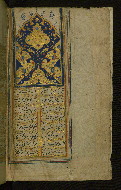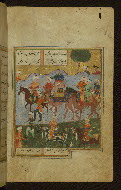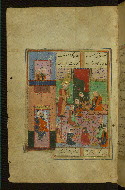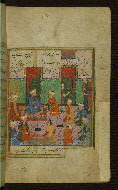Home > Digitized Walters Manuscripts
This document is a tranformation of a TEI P5 XML manuscript description incorporating images. If you have trouble reading special or non-Latin characters on this page, please make sure you have appropriate Unicode fonts installed and an up-to-date web browser.
Walters Ms. W.644, Yusuf and Zulaykha
Browse images (Browse images in a new window) | TEI in XML format
W.644
Yusuf and Zulaykha
Vernacular: يوسف وزليخا
Authority name: Jāmī, 1414-1492
As-written name: Nūr al-Dīn ʿAbd al-Raḥmān ibn Aḥmad Jāmī
Name, in vernacular: نور الدين عبد الرحمان بن احمد جامي
Note: Author dates preferred by cataloger: d. 898 AH / 1492 CE
This manuscript is an illuminated and illustrated copy of the famous story of Joseph and Potiphar's wife (Yūsuf va Zulaykhā) by Nūr al-Dīn Jāmī (d. 898 AH / 1492 CE), executed in the tenth century AH / sixteenth CE in Safavid Iran. The text is written in black nasta‘līq script and begins with a double-page illuminated incipit with headpiece (fol. 1b-2a). The manuscript contains three illustrations (fols. 50b, 116a, and 150b). The dark brown goatskin binding, which is original to the manuscript, has panel-stamped designs and red doublures with gold filigree work over colored paper.
10th century AH / 16th CE
Iran
Book
Literary -- Poetry
The primary language in this manuscript is Persian.
Paper
Cream-colored laid paper
Foliation: 174
Catchwords: Written obliquely outside the frame on versos
14.0 cm wide by 22.0 cm high
6.5 cm wide by 13.5 cm high
- Columns: 2
- Ruled lines: 12
- Framing lines in gold, green, orange, black, brown, and blue
- Title: Yūsuf va Zulaykhā
- Author: Jāmī, 1414-1492
- Incipit: الهى غنچه اميد بكشاى ...
- Hand note: Text written in nastaʿlīq script in black ink; chapter headings written in nastaʿlīq script in white ink
- Decoration note: Double-page illuminated incipit with headpiece (fol. 1b-2a); interlinear gilt illumination (fol. 1b-2a); framing lines in gold, green, orange, black, brown, and blue; rectangular panels for chapter/section headings
fol. 1b:

- Title: Illuminated incipit page with headpiece
- Form: Incipit; headpiece
- Label: This illuminated incipit has a blue and gilt headpiece with polychrome floral decoration. The text, divided into two columns, has interlinear gilt illumination with additional floral decoration.
fol. 50b:

- Title: Zulaykha traveling to the Aziz of Egypt, her future husband
- Form: Illustration
- Label: This illustration depicts Zulaykha in a blue-domed litter on a camel led by a cameleer. The retinue is entering the capital of Egypt.
fol. 116a:

- Title: Egyptian women overwhelmed by Yūsuf's beauty
- Form: Illustration
- Label: This illustration depicts Yūsuf, who is identified by a flaming halo, entering a room where Egyptian women sit peeling fruit with knives. According to the narrative, the women were so distracted by Yūsuf's incomparable beauty that they inadvertently cut their hands.
fol. 150b:

- Title: Yūsuf gives a royal banquet in honor of his marriage
- Form: Illustration
- Label: Once Yūsuf, depicted here with a flaming halo and seated at the left side of the composition, received divine approval to marry Zulaykhā, he organized a banquet to which he invited the Egyptian king and officials. The banquet takes place in an interior defined by two curtained windows and tiled walls with floral decoration.
The binding is original.
Dark brown goatskin (with flap); panel-stamped central and border divisions with floral and vine designs, brushed with gold; red doublures with central lobed medallion and cornerpieces of gold filigree work over colored paper that has significant loses
Pāpās-zādah[…], dated [1]311 AH / 1893-4 CE (fol. 1a)
Walters Art Museum, 1931, by Henry Walters bequest
Gacek, Adam. Persian Manuscripts in the Libraries of McGill University: Brief Union Catalogue. (Montreal: McGill University Libraries, 2005), no. 334.
Richard, Francis. Catalogue des manuscrits persans. (Paris: Bibliothèque nationale, 1989), nos. 356, 359-361, 369.
Principal cataloger: Gacek, Adam
Catalogers: Landau, Amy; Smith, Sita
Editor: Bockrath, Diane
Conservators: Jewell, Stephanie; Quandt, Abigail
Contributors: Barrera, Christina; Emery, Doug; Herbert, Lynley; Noel, William; Simpson, Shreve; Tabritha, Ariel; Toth, Michael B.; Valle, Chiara
The Walters Art Museum
Licensed for use under Creative Commons Attribution-NonCommercial-ShareAlike 3.0 Unported Access Rights, http://creativecommons.org/licenses/by-nc-sa/3.0/legalcode. It is requested that copies of any published articles based on the information in this data set be sent to the curator of manuscripts, The Walters Art Museum, 600 North Charles Street, Baltimore MD 21201.